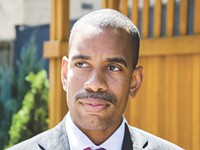[
{
"name": "500x250 Ad",
"insertPoint": "5",
"component": "15667920",
"parentWrapperClass": "",
"requiredCountToDisplay": "1"
}
]
Now that the inauguration is over, the confetti has been swept up, the temporary seating and fancy bunting has been put away for another four years, we can finally ask the forbidden question: Was this election on the level?
Big media, with its overarching saturation of gee-whiz coverage, seems to be saying a resounding "yes." When US Senator Barbara Boxer joined 33 Democratic representatives on January 6 to challenge the Ohio electoral vote, the story was relegated to snide Republican remarks about conspiracy theories. But to many, the basic concept of electoral honesty, first exposed in Florida in 2000, is now an open question in 2004, not only in Ohio, but across the country.
The mainstream media seems unwilling to put any effort into exploring the issue. Is the invisible elephant in the room --- the honesty of elections, the most fundamental concept of a democracy --- just too big to even acknowledge?
By now there is a major news story sitting way under the radar. It concerns the wide discrepancy between the exit polls last November and the "actual" results. As political operative Dick Morris, no friend of Democrats, wrote in an article for The Hill:"Exit polls are almost never wrong. They eliminate the two major sources of polling errors, separating who says they will vote and who actually votes and the undecideds."
In ABC News' exit polls, Kerry won Florida, Ohio, New Mexico, Colorado, Nevada, and Iowa, all of which went to Bush. The networks are extremely reluctant to release exit-poll information, and we wonder why. Lewis Lapham in Harper's magazine wrote that on a national basis, exit polls showed a 3 percentage point Kerry victory, while the actual results showed a 3 percentage point Bush victory, a 6 point swing.
It gets worse. In states where verifiable paper trails were available, the exit polls corresponded almost exactly with the actual results. In states using touch-screen electronic voting with no verifiable paper trail, the "official" results varied by as many as nine percentage points from exit polls. In 10 of 11 swing states, the final results moved in Bush's direction compared to the exit polls.
Roughly one third of the national vote was tabulated by electronic voting machines, many of which were produced and maintained by Diebold. Top Diebold executives are on record publicly as partisan Republicans. How good are the exit polls? Republicans claim they are wildly inaccurate, naturally. Up until the 2000 election they were viewed as the most reliable indicator of an election and relied upon by the networks so they could be the first to call a result. That all changed in Florida 2000. Was that when exit polls became inaccurate, or when the results became inaccurate?
This issue is clearly national in scope, even in Red states where the Bush vote was inevitably higher than expected or projected by exit polls. Were the Bush numbers being artificially padded in those states to insure a national popular vote majority? And, of course, these were non-swing states so there wasn't much scrutiny of the voting.
However, there was extensive scrutiny in Ohio, which was the basis of the challenge in Congress on January 6. Led by Congressman John Conyers and a contingent of election-monitoring groups, they found a disturbing collection of irregularities. Some of the highlights:
1) The election and subsequent recount was administered by Republican Secretary of State Kenneth Blackwell, who was also co-chair of the Bush campaign in Ohio. This was an unfortunate repetition of the fiasco in Florida with Katherine Harris.
2) There are 106,000 votes that were uncounted that supposedly did not show a choice for president. These votes were not physically inspected to see why no presidential vote was recorded. Most uncounted votes came from precincts where Kerry was strongest.
3) Reported turnouts in many precincts were impossible. In southern Ohio's PerryCounty, which has a heavy Republican voting tendency, several precincts reported turnouts of more than 100 percent of registered voters. In many other areas, turnouts of 95 to 98 percent were reported, which was 30 to 40 percent higher than normal. Many Cleveland precincts reported turnouts between 7 and 20 percent, despite reports of record crowds trying to use an inadequate number of voting machines.
4) In several counties, election results for Ohio Supreme Court positions were totally inconsistent with the presidential vote. A liberal Supreme Court candidate received more votes than Bush, but Kerry trailed both by a wide margin. In another county, a conservative Supreme Court candidate ran 40 percent below Bush and about even with the reported Kerry vote. Such outcomes seem inconceivable, and all the discrepancies invariably favored Bush in every anomalous comparison.
5) Despite the many complaints and obvious problems, the vote as tabulated was eventually certified by Kenneth Blackwell. The mandatory recount was managed by Blackwell, who selected the required 3 percent sampling in areas where there were no reported discrepancies. The vote was then officially certified and the Republican electors were sent to Washington.
This is a small summary of the situation in Ohio. Similar irregularities occurred in many other states. If you would like to read more complete coverage of the many instances of highly questionable election-day events throughout the country, consult freepress.org, ustogether.org, blackboxvoting.org, and commondreams.org.
The mainstream media won't touch this story. If they did, look at the implications. The legitimacy of the presidency would be in question. And that question is just too big. The situation in Florida 2000 was even worse. There is every reason to believe that if the Florida election had been totally legitimate, Al Gore would be president today.
Was the 2004 election stolen? Even the most partisan Democrats don't make that claim. But the totality of the results simply cannot be trusted. And that is a sad commentary on the state of the world's greatest democracy.
Laurence W. Britt is a writer living in Fairport. He has written or co-written four books and several articles on political and economic affairs. He was profiled in the December 8, 2004 issue of City Newspaper.
Speaking of Bush, election
Latest in Columns
More by Laurence W. Britt
-
Is ignorance bliss?
Nov 9, 2005 -
Flipping the bird
Aug 17, 2005 -
Hot news, cold news
Jul 27, 2005 - More »








